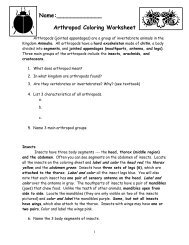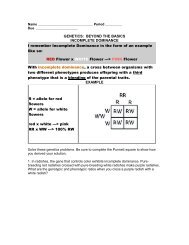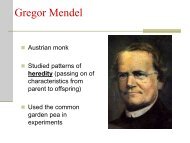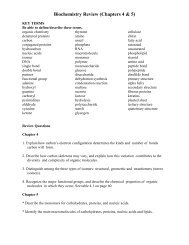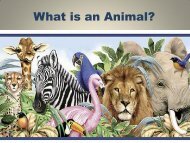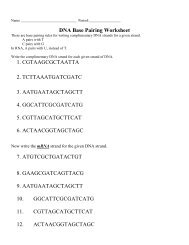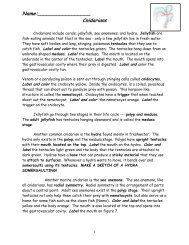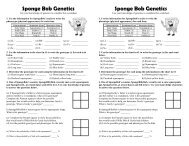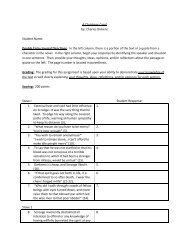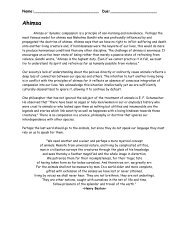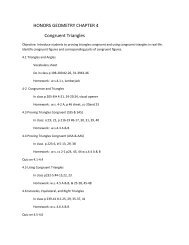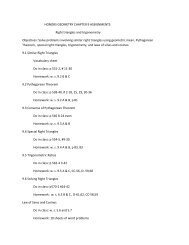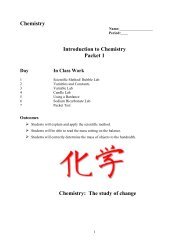6.1 Chromosomes and Meiosis
6.1 Chromosomes and Meiosis
6.1 Chromosomes and Meiosis
You also want an ePaper? Increase the reach of your titles
YUMPU automatically turns print PDFs into web optimized ePapers that Google loves.
<strong>6.1</strong> <strong>Chromosomes</strong> <strong>and</strong> <strong>Meiosis</strong>KEY CONCEPTGametes have half the number of chromosomesthat body cells have.
<strong>6.1</strong> <strong>Chromosomes</strong> <strong>and</strong> <strong>Meiosis</strong>You have body cells <strong>and</strong> gametes.• Body cells are also called somatic cells.• Sex cells develop into gametes.– Gametes are sex cells: egg <strong>and</strong> sperm.– Gametes have DNA that can be passed tooffspring.body cells sex cells (sperm) sex cells (egg)
<strong>6.1</strong> <strong>Chromosomes</strong> <strong>and</strong> <strong>Meiosis</strong>Your cells have autosomes <strong>and</strong> sex chromosomes.• Your body cells have 23 pairsof chromosomes.– Homologous pairs ofchromosomes have thesame structure.– For each homologous pair,one chromosome comesfrom each parent.• Chromosome pairs 1-22 areautosomes.• Sex chromosomes, X <strong>and</strong> Y,determine gender in mammals.
<strong>6.1</strong> <strong>Chromosomes</strong> <strong>and</strong> <strong>Meiosis</strong>Body cells are diploid; gametes are haploid.• Fertilization between egg <strong>and</strong> sperm occurs in sexualreproduction.• Diploid (2n) cells have two copies of everychromosome.– Body cells are diploid.– Half the chromosomes come from each parent.
<strong>6.1</strong> <strong>Chromosomes</strong> <strong>and</strong> <strong>Meiosis</strong>• Haploid (n) cells have one copy of everychromosome.– Gametes are haploid.– Gametes have 22 autosomes <strong>and</strong> 1 sexchromosome.
<strong>6.1</strong> <strong>Chromosomes</strong> <strong>and</strong> <strong>Meiosis</strong>• Chromosome number must be maintained in animals.• Many plants have more than two copies of eachchromosome.• Mitosis <strong>and</strong> meiosis are types of nuclear division thatmake different types of cells.• Mitosis makesmore diploid cells.
<strong>6.1</strong> <strong>Chromosomes</strong> <strong>and</strong> <strong>Meiosis</strong>• <strong>Meiosis</strong> makes haploid cells from diploid cells.– <strong>Meiosis</strong> occurs in sex cells.– <strong>Meiosis</strong> produces gametes.
<strong>6.1</strong> <strong>Chromosomes</strong> <strong>and</strong> <strong>Meiosis</strong>Word RootsKnowing word roots can improveyour vocabulary!• a- = not or without (asexual: type ofreproduction not involvingfertilization)• auto- = self (autosome: thechromosomes that do not determinegender)
<strong>6.1</strong> <strong>Chromosomes</strong> <strong>and</strong> <strong>Meiosis</strong>KEY CONCEPTDuring meiosis, diploid cells undergo two celldivisions that result in haploid cells.
<strong>6.1</strong> <strong>Chromosomes</strong> <strong>and</strong> <strong>Meiosis</strong>Cells go through two rounds of division in meiosis.• <strong>Meiosis</strong> reduces chromosome number <strong>and</strong> createsgenetic diversity.
<strong>6.1</strong> <strong>Chromosomes</strong> <strong>and</strong> <strong>Meiosis</strong>REMEMBER: Homologous chromosomes• The twochromosomes ofeach pair in adiploid cell arecalledhomologouschromosomes.
<strong>6.1</strong> <strong>Chromosomes</strong> <strong>and</strong> <strong>Meiosis</strong>• <strong>Meiosis</strong> I <strong>and</strong> meiosis II each have four phases, similar tothose in mitosis.– Pairs of homologous chromosomes separate inmeiosis I.– Homologous chromosomes are similar but not identical.– Sister chromatids divide in meiosis II.– Sister chromatids are copies of the same chromosome.homologous chromosomessisterchromatidssisterchromatids
<strong>6.1</strong> <strong>Chromosomes</strong> <strong>and</strong> <strong>Meiosis</strong>• <strong>Meiosis</strong> I occurs after DNA has been replicated.• <strong>Meiosis</strong> I divides homologous chromosomes in four phases.
<strong>6.1</strong> <strong>Chromosomes</strong> <strong>and</strong> <strong>Meiosis</strong>• <strong>Meiosis</strong> II divides sister chromatids in four phases.• DNA is not replicated between meiosis I <strong>and</strong>meiosis II.
<strong>6.1</strong> <strong>Chromosomes</strong> <strong>and</strong> <strong>Meiosis</strong>Prophase I – crossing over• Chromatids are wrapped sotightly the chromosomescan actually break <strong>and</strong>exchange genetic materialin a process known ascrossing over.• Crossing over results innew combinations of alleleson a chromosome.
<strong>6.1</strong> <strong>Chromosomes</strong> <strong>and</strong> <strong>Meiosis</strong>Metaphase I – (Same as before)• The centromere of eachchromosome attachesto a spindle fiber.• The spindle fibers pullthe tetrads into themiddle, or equator, ofthe spindle.
<strong>6.1</strong> <strong>Chromosomes</strong> <strong>and</strong> <strong>Meiosis</strong>Anaphase I – (Same as before)• Homologouschromosomes separate<strong>and</strong> move to oppositeends of the cell.• This critical stepensures that each newcell will receive only onechromosome from eachhomologous pair.
<strong>6.1</strong> <strong>Chromosomes</strong> <strong>and</strong> <strong>Meiosis</strong>Telophase I – (Same as before)• The spindle is brokendown, the chromosomesuncoil, <strong>and</strong> the cytoplasmdivides to yield two newcells.• Each cell has half the DNAas the original cell becauseit has only onechromosome from eachhomologous pair.
<strong>6.1</strong> <strong>Chromosomes</strong> <strong>and</strong> <strong>Meiosis</strong>Prophase II• A spindle forms ineach of the twonew cells <strong>and</strong> thespindle fibersattach to thechromosomes.
<strong>6.1</strong> <strong>Chromosomes</strong> <strong>and</strong> <strong>Meiosis</strong>Metaphase II.• The chromosomes,still made up ofsister chromatids,are pulled to thecenter of the cell<strong>and</strong> line upr<strong>and</strong>omly at theequator.
<strong>6.1</strong> <strong>Chromosomes</strong> <strong>and</strong> <strong>Meiosis</strong>Anaphase II• The centromereof eachchromosomesplits.• The sisterchromatids toseparate <strong>and</strong>move to oppositepoles.
<strong>6.1</strong> <strong>Chromosomes</strong> <strong>and</strong> <strong>Meiosis</strong>Telophase II• Finally nuclei reform,the spindlesbreakdown, <strong>and</strong> thecytoplasm divides.• Four haploid cellshave been formedfrom one diploidcell
<strong>6.1</strong> <strong>Chromosomes</strong> <strong>and</strong> <strong>Meiosis</strong>• <strong>Meiosis</strong> differs from mitosis in significant ways.– <strong>Meiosis</strong> has two cell divisions while mitosis has one.– In mitosis, homologous chromosomes never pair up.– <strong>Meiosis</strong> results in haploid cells; mitosis results in diploidcells.
<strong>6.1</strong> <strong>Chromosomes</strong> <strong>and</strong> <strong>Meiosis</strong>Why meiosis is important1. Forms gametes forsexual reproduction2. Crossing over duringmeiosis whichrearranges allelecombinations so thatthe offspringgenerations aregenetically differentthan the parents.
<strong>6.1</strong> <strong>Chromosomes</strong> <strong>and</strong> <strong>Meiosis</strong>Haploid cells develop into mature gametes.• Gametogenesis is the productionof gametes.• Gametogenesis differs betweenfemales <strong>and</strong> males.– Sperm become streamlined <strong>and</strong>motile.– Sperm primarily contribute DNAto an embryo.– Eggs contribute DNA, cytoplasm,<strong>and</strong> organelles to an embryo.– During meiosis, the egg getsmost of the contents; the othercells form polar bodies.
<strong>6.1</strong> <strong>Chromosomes</strong> <strong>and</strong> <strong>Meiosis</strong>Word RootsKnowing word roots can improve yourvocabulary!• di- = two (diploid: cells that containtwo homologous sets ofchromosomes)• fertil- = fruitful (fertilization: processof fusion of a haploid sperm <strong>and</strong> ahaploid egg cell)



